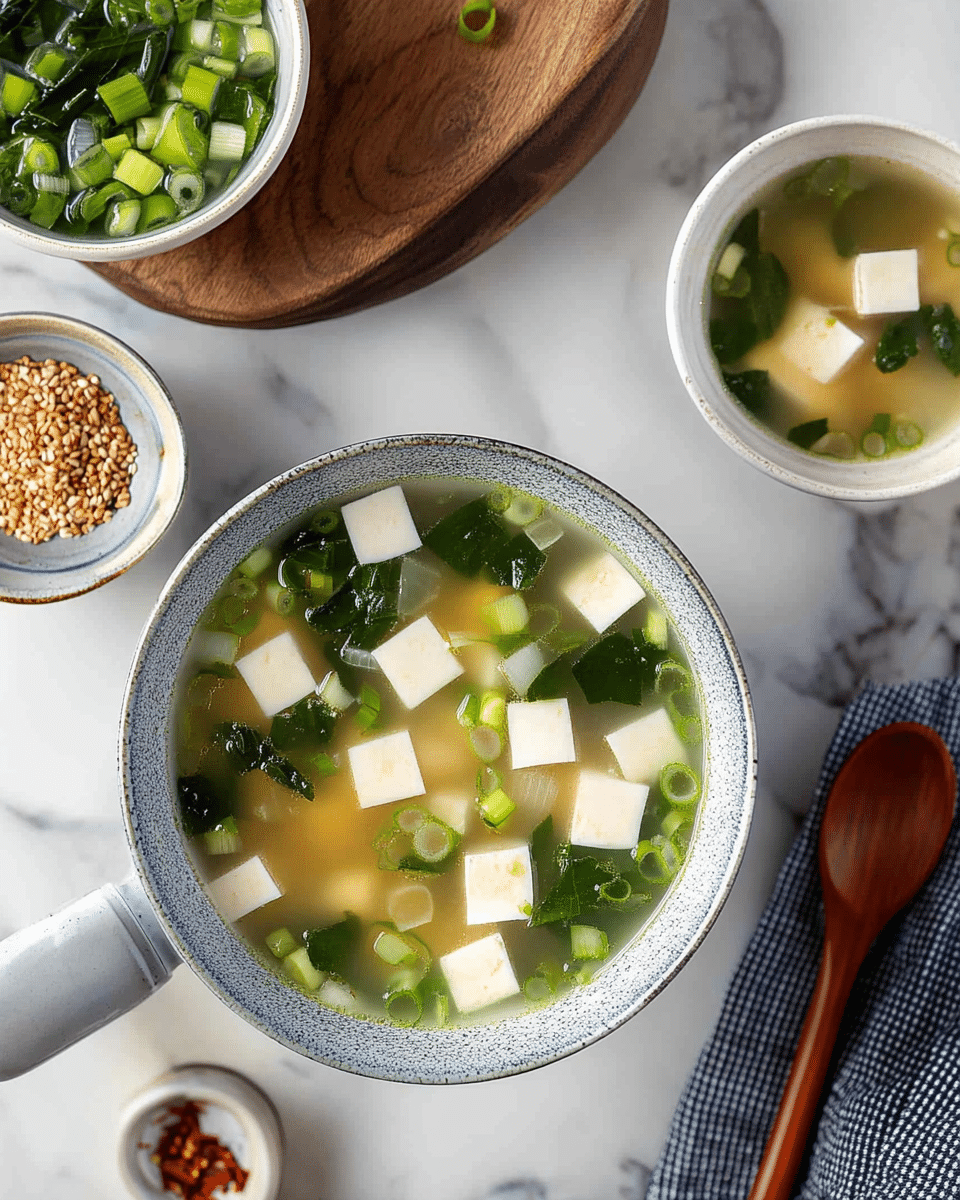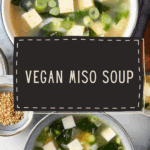Miso soup is a classic Japanese dish that’s simple, nourishing, and full of umami flavor. It features a delicate broth made with kombu (edible kelp), miso paste, and is traditionally filled with tofu, seaweed, and green onions. This version is authentic, easy to prepare, and comes together in just 20 minutes—perfect for a light appetizer or a warming side dish.
Why You’ll Love This Recipe
This miso soup recipe is a beautiful balance of simplicity and depth. It’s made with clean, plant-based ingredients and delivers bold flavor without the need for complicated cooking techniques. It’s perfect for those looking for a light, savory start to their meal or a quick, comforting soup any time of day. Plus, it’s gluten-free, vegan, and highly customizable.

Ingredients
(Tip: You’ll find the full list of ingredients and measurements in the recipe card below.)
-
1 (3-inch) piece kombu
-
4 cups water
-
3 tablespoons wakame (dried seaweed)
-
¼ cup white miso paste
-
⅓ cup chopped green onion
-
6 ounces silken tofu, cubed
-
Tamari, to taste
Directions
-
Gently rinse the kombu and place it in a medium pot with 4 cups of water.
-
Simmer over low heat for 10 minutes—do not allow the water to boil, as boiling can make the kombu bitter.
-
While the kombu simmers, soak the wakame in a small bowl of warm water for at least 5 minutes to rehydrate.
-
Remove the kombu from the pot and discard or save for another use.
-
In a small bowl, mix the miso paste with a few spoonfuls of hot broth until smooth, then stir this mixture back into the pot.
-
Drain the wakame and add it to the soup along with the chopped green onions and cubed silken tofu.
-
Simmer the soup gently over very low heat for 1 to 2 minutes.
-
Season with tamari to taste and serve warm.
Servings and timing
This recipe serves 4 people.
Prep time: 8 minutes
Cook time: 12 minutes
Total time: 20 minutes
Variations
-
Add mushrooms: Sliced shiitake or enoki mushrooms add extra umami and texture.
-
Use different miso: Try red or yellow miso for a deeper, saltier flavor profile.
-
Spicy version: Add a dash of chili oil or a sprinkle of togarashi for heat.
-
Greens boost: Stir in baby spinach or bok choy during the final minutes of cooking.
-
Grainy touch: Serve with a scoop of cooked rice or quinoa for a heartier bowl.
Storage/Reheating
Miso soup is best enjoyed fresh, but you can store leftovers in an airtight container in the refrigerator for up to 3 days. To reheat, warm gently on the stovetop over low heat—avoid boiling to preserve the probiotic benefits of the miso. If reheating in the microwave, use short bursts and stir often. Avoid freezing, as tofu and seaweed can change texture.
FAQs
What is kombu and where can I find it?
Kombu is an edible kelp used in Japanese cooking, commonly found in Asian markets or online in the dried foods section.
Can I make miso soup without kombu?
Yes, but kombu provides the essential base flavor. If unavailable, use a vegetable broth or a dash of mushroom powder as an alternative.
Is miso soup vegan?
Yes, this version is completely vegan. Traditional versions may include fish-based dashi, so it’s always good to check or make your own.
What kind of miso should I use?
White miso is mild and slightly sweet, perfect for a balanced miso soup. Red miso is stronger and saltier if you prefer more punch.
Can I add noodles to miso soup?
Absolutely. Udon, soba, or even rice noodles can be added for a more filling meal.
Is wakame necessary?
Wakame adds texture and a briny flavor, but you can leave it out or substitute with other sea greens.
Can I make it ahead of time?
Yes, but for the best flavor and texture, add tofu and miso after reheating rather than storing them in the soup.
Why shouldn’t I boil miso?
Boiling can kill the beneficial probiotics in miso and affect the flavor. Always add miso off the heat or at a low simmer.
How do I make the soup gluten-free?
Ensure your tamari and miso paste are labeled gluten-free, as some versions may contain wheat.
Can I use firm tofu instead of silken?
Yes, firm tofu holds its shape better but won’t have the same silky texture. Choose based on your preference.
Conclusion
Miso soup is a quick and nourishing dish that brings authentic Japanese flavor to your table with minimal effort. With just a few ingredients and a short cooking time, you can enjoy a warm, umami-rich bowl that’s perfect for any occasion. Whether you’re new to Japanese cooking or a seasoned home chef, this miso soup is a timeless favorite worth keeping in your recipe collection.
Print
Miso Soup
- Total Time: 20 minutes
- Yield: 4 servings
- Diet: Vegan
Description
Learn how to make miso soup at home with this simple, traditional Japanese recipe. Nourishing, umami-rich, and ready in just 20 minutes, it’s the perfect light and healthy starter or side dish.
Ingredients
- 1 (3-inch) piece kombu
- 4 cups water
- 3 tablespoons wakame dried seaweed
- ¼ cup white miso paste
- ⅓ cup chopped green onion
- 6 ounces silken tofu, cubed
- Tamari, to taste
Instructions
- Gently rinse the kombu piece. Place it in a medium pot with the water and gently simmer for 10 minutes. Avoid boiling to prevent bitterness.
- Soak the wakame in a small bowl of warm water for at least 5 minutes to rehydrate.
- Remove the kombu from the soup. In a small bowl, mix the miso paste with some hot broth until smooth, then stir it back into the soup.
- Drain the wakame and add it to the soup along with the green onions and cubed tofu.
- Simmer over very low heat for 1 to 2 minutes.
- Season to taste with tamari and serve warm.
Notes
- Use low heat after adding miso paste to preserve its probiotics.
- Adjust miso quantity for a stronger or milder flavor.
- Add mushrooms or spinach for extra depth and nutrition.
- Prep Time: 8 minutes
- Cook Time: 12 minutes
- Category: Side Dish
- Method: Simmering
- Cuisine: Japanese
Nutrition
- Serving Size: 1 cup
- Calories: 60
- Sugar: 1g
- Sodium: 670mg
- Fat: 2g
- Saturated Fat: 0.3g
- Unsaturated Fat: 1.5g
- Trans Fat: 0g
- Carbohydrates: 5g
- Fiber: 1g
- Protein: 5g
- Cholesterol: 0mg







